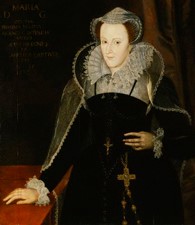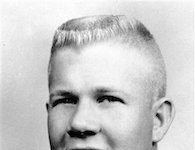On February 8, 1587, Mary I of Scotland was beheaded for her alleged role in a conspiracy against her cousin Queen Elizabeth I of England.
The Life and Execution of Mary, Queen of Scots
Mary Stuart, the Catholic queen of Scotland, was a claimant to the English throne who had the support of English Catholics and was considered a threat to her cousin Elizabeth, the Protestant queen of England.
Raised in France, Mary returned to Scotland in 1561 and reigned with an uneasy relationship with Protestant Scottish nobles. In 1567, Mary’s second husband, Henry Darnley, was murdered in a plot that likely involved Mary, the Earl of Bothwell and other nobles. Months later, after Mary married Bothwell, the nobles turned on the couple, inciting the public by accusing them of Darnley’s murder.
Mary was arrested, imprisoned in Loch Leven Castle and forced to abdicate her throne in favor of her one-year-old son James. She escaped from Loch Leven in May 1568, and, after unsuccessfully trying to raise an army to reclaim her throne, fled Scotland for England. On Mary’s arrival, Elizabeth had little choice but to imprison her cousin.
Mary was to spend 18 years of her life in prison. Elizabeth’s advisers urged the queen to put her rival to death, but Elizabeth balked at killing her blood relative. Two Catholic plots to kill Elizabeth and place Mary on the English throne were uncovered: the Ridolfi plot in 1570 and the Babington plot in 1586.
Mary was tried for treason in October 1586 for her role in the Babington plot; she was convicted and sentenced to death by beheading. Elizabeth, who had rejected Parliament’s calls in 1572 to kill Mary over the Ridolfi plot, was reluctant to sign her cousin’s death warrant. She finally did so in February 1587.
Related Events
- Spanish Inquisition
- Martin Luther and the Protestant Reformation
- Elizabeth I’s Coronation
- Guy Fawkes and the Gunpowder Plot
In Mary’s final letter, written to her brother-in-law Henri III of France six hours before her execution, she expressed a belief that “she was dying a religious martyr,” according to the National Library of Scotland.
“I scorn death and vow that I meet it innocent of any crime, even if I were their subject,” she wrote. “The Catholic faith and the assertion of my God-given right to the English crown are the two issues on which I am condemned, and yet I am not allowed to say that it is for the Catholic religion that I die, but for fear of interference with theirs.”
At 8:00 a.m. on February 8, 1587, the former Queen of Scotland was beheaded. A first-hand account reports an undignified end. The axman had to strike twice to remove Mary’s head. Then when he lifted her severed head, Mary’s wig was removed and the audience was startled by the short, gray hair that was revealed.
Sources in this Story
- The BBC: Mary, Queen of Scots, and the Earl of Bothwell
- Luminarium: Encyclopedia Project: Mary Queen of Scots
- Newberry Library: Elizabeth I: The Execution of Mary Queen of Scots
- National Library of Scotland: The Last Letter of Mary Queen of Scots
- National Library of Scotland: Mary’s Execution
- New Advent Catholic Encyclopedia: Mary Queen of Scots
- The BBC: Elizabeth I
Mary, Queen of Scots
Mary Stuart, daughter of King James V, King of Scots, and great-granddaughter of King Henry VII of England, became queen of Scotland when she was just 6 days old. After negotiations to betroth her to the son of King Henry VIII failed, she was betrothed to Francis, the dauphin of France, and sent to France when she was 5 years old.
Mary was instilled with a strong Catholic faith, and she was remembered fondly in the Catholic world. “During the whole process of her trial and execution, Mary acted with magnificent courage worthy of her noble character and queenly rank,” writes the Catholic Encyclopedia. “There can be no question that she died with the charity and magnanimity of a martyr; as also that her execution was due, on the part of her enemies, to hatred of the Faith.”
Queen Elizabeth I
Elizabeth, daughter of Henry VIII and Anne Boleyn, ascended to the English throne in 1558, succeeding her half-sister Mary. She was a brilliant and charismatic, but occasionally indecisive leader, who ruled England during a 44-year “Golden Age.”
“Elizabeth’s greatest achievement lay in the relationship she had forged with her people,” writes the BBC. “She was ahead of her time in her grasp of public relations, and her popularity had remained undimmed…Elizabeth was rewarded with loyalty and, enhanced by the glow of nostalgia, her own unique place in history.”











